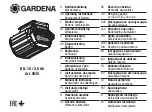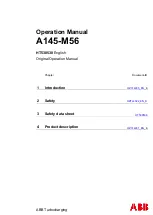
O P E R A T I N G I N S T R U C T I O N S
°
Version10/08
230V Quick Charger 1A
Item-No. 23 57 04
Intended use
The device serves to charge Ni-Cd/NiMH accumulator packs with a cell count of
2, 4, 5, 6, 7, 8 or 10. This corresponds to a charging voltage of 2.8 to 14V. The char-
ging current can be adapted to the respective accumulator in two stages (0.5A / 1A).
There is a discharge function for Ni-Cd accumulators to prevent the memory effect.
After the accumulator is discharged, the quick charger automatically switches to
charge mode. The intelligent minus delta V charge cutoff detects a full accumulator
and automatically switches to „trickle charge“. The accumulator is not overcharged
and retains its charge status.
A LED provides information about the current operating status.
A protective cut-off automatically interrupts the charging process after 6 hours. A
longer charging time most often indicates a defect accumulator.
The connections can be exchanged on the charger depending on the applied accu-
mulator system.
It is not permitted to charge batteries (zinc-carbon, alkaline, etc.), lead or lithium
accumulator (Li-Ion, LiPo, etc.).
The charger may only be connected an operated with 230 V alternate current.
The plug-type charger is protected against overload and short-circuiting. Observe
the polarity at the charge output!
Uses other than those described above are not permitted and may damage the pro-
duct. Misuse may also lead to risks such as short circuiting, fire, electrical shocks.
No part of the product may be modified or converted.
The safety instructions must be observed.
Safety instructions
Please read through the operating instructions completely before
using the product for the first time; they include important informa-
tion necessary for correct operation.
The guarantee will be rendered null and void if damage is caused
as a result of failure to observe the operating instructions. We will
not assume any responsibility for consequential damage!
We will also not assume any responsibility for damage to assets or
for personal injury caused by improper handling or failure to observe
the safety instructions. The warranty will be rendered null and void in
such cases.
For safety and licensing (CE) reasons, unauthorised conversion and/or modifications
to electronic devices are not permitted.
Do not leave chargers or accumulators unattended when in operation.
To ensure safe operation, the user should comply with the safety instructions and
warnings contained in these operating instructions.
The construction corresponds to protection class II (double or reinforced insulation).
Ensure that the insulation (of the housing or the main cable) is neither damaged nor
destroyed.
Chargers and accessories should be kept out of the reach of children! It is not a toy.
In commercial institutions, the accident prevention regulations of the Employer’s
Liability Insurance Association for Electrical Systems and Operating Materials are to
be observed.
In schools, training centres, hobby and self-help groups, the use of chargers and
accessories should be closely supervised by trained personnel.
Avoid using the appliance under unfavourable ambient conditions. Otherwise the
sensitive electronic parts inside of the charger risk being damaged, and could be life
threatening to the user. Adverse ambient conditions are:
- Excess air humidity (> 75 % rel., condensing)
- Dampness
- Dust and inflammable gases, vapours or solvents, petrol
- Excessive ambient temperatures (> approx. +40°C)
- Strong vibrations
When charging accumulators, always observe the charging regulations of the accu-
mulator manufacturer concerned.
In the case of incorrect handling (excessive charging current or incorrect polarity),
the accumulator can be overcharged or destroyed. In the worst case, the accumu-
lator could explode and cause considerable damage.
Keep transmitting devices (mobile telephone, transmitting systems for model making
etc.) away from chargers as the transmitter signal could interfere with charging and
possibly break the charger and thus the accumulator.
Never connect your charger to the mains immediately after it has been
taken from a cold room to a warm one. The resulting condensation could,
under adverse circumstances, destroy the appliance. Allow the device to
reach room temperature before switching it on.
If you have reason to believe that the device can no longer be operated safely,
disconnect it immediately and secure it against being operated unintentionally.
It can be assumed that safe operation is no longer possible if:
- the device is visibly damaged,
- it does not function any longer
- if it has been stored for long periods of time under unfavourable conditions
- if it has been subject to considerable stress in transit.
A triangle containing an exclamation mark indicates important informa-
tion in these operating instructions which is to be observed without fail.
☞
The “hand” symbol indicates special information and advice on opera-
tion of the device.
Connection
When connecting accumulators, always observe the charging instructions of the
accumulator manufacturer concerned.
Use the enclosed key to set the charging voltage and current.
Select the matching voltage for your accumulator on the left variable transformer.
Select the respective cell number (C = cell).
Select the matching charging current for your accumulators on the right variable
transformer.
The charging current should not exceed the value of 0.4 of the accumulator capacity.
Example:
1200 mAh * 0.4 = 480 mAh
➔
500 mA charging current (= 0.5A)
2500 mAh * 0.4 = 1000 mAh
➔
1000 mA charging current (= 1A)
Select the respective charging current.
With quick-charge accumulators, the charging current may not exceed the accu-
mulator capacity (e.g. accumulator 1000 mAh —> charging current 1A). When in
doubt, always select the lower charging current range.
Connect the plug system matching your accumulator pack to the charger.
The white racing pack plug as well as the alligator clip are protected against wrong
polarity and only fit onto the charging cable in the right polarity.
The round 5.5 mm hollow plug can be used without having to observe the polarity.
Observe the illustration below to adjust the right polarity on the hollow plug.
+
+
-
-
VOLTCRAFT
®


























